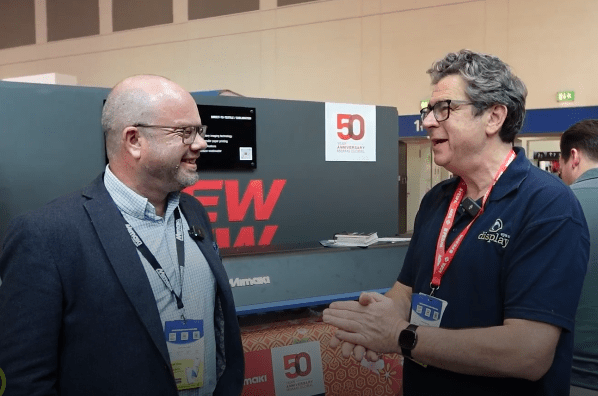Jack talks to Hybrid Services’ Duncan Jefferies at FESPA about the new Mimaki TX330 Textile Printer
Transcript of video
Jack Gocher: …I’m delighted to see Duncan Jefferies from Hybrid in the UK, the distributor there. Now, there are loads of new products that we’re lucky to have seen announced. Over the last year, there have been loads, and more new products this year at this show, but you particularly wanted to talk about the new Mimaki TX330.
Duncan Jefferies: Yeah, I agree. It’s the new Mimaki TX330, a 1.8-metre direct-to-textile printer, but it will also do dye-sublimation. So, at the moment, we are printing onto uncoated cotton with pigment inks. What we can also do is run polyester through it and print direct to that. And we can also run transfer paper through it and print to that, to then sublimate onto polyester as well.

So, we’re kind of covering both bases. Like its predecessors in the Mimaki textile line-up over the last twenty-something years, this machine can also run dual inks. So, for small print bureaus, for universities, colleges who need flexibility, who don’t necessarily need to do high-volume print runs – whilst this does offer a significant uplift in productivity against the machine it replaces – it gives us the ability to be really flexible. One job could be a few metres of cotton printed with pigment, another job could be a dye-sublimation print, and you can be to-ing and fro-ing between the two.
Jack Gocher: So, this is a big change in a way, isn’t it? Because all these technologies used to be in different machines; you’d have to invest in different machines. So now you’re getting it all into one. You’re doing yourself out of sales, for one thing! But from a customer’s point of view, that’s fantastic, isn’t it? It really gives them more options.
Mimaki TX330 flexibility
Duncan Jefferies: It does; it gives a lot of flexibility – the ability to respond to different needs from customers, to sell complementary products as well. So, you might have a furnishings collection that could be made up of linen, cotton, as well as polyester mixes, poly-cotton materials for cushions, contract furnishings, curtains, bedding – whatever it might be. All could be printed and produced on the same machine.
Jack Gocher: Now, I’m looking around the stand here, and I keep seeing these women with incredible outfits. Is that all done on this technology?
Duncan Jefferies: It’s been printed across the range of Mimaki textile technology we’ve got on the stand. We’ve got dye-sublimation, we’ve got direct-to-textile, we’ve got DTF, and we’ve got the TRAPIS system as well, which is a real revolutionary one. So, Mimaki’s commitment to textile printing is unparalleled, and it has been since the late 1990s. This is the latest iteration.
Related stories
Mimaki Europe reveals vision and strategy at FESPA 2025
Hybrid to introduce two new Mimaki direct to textile printers
